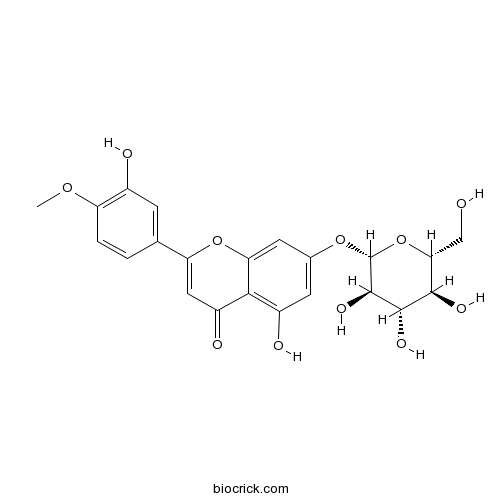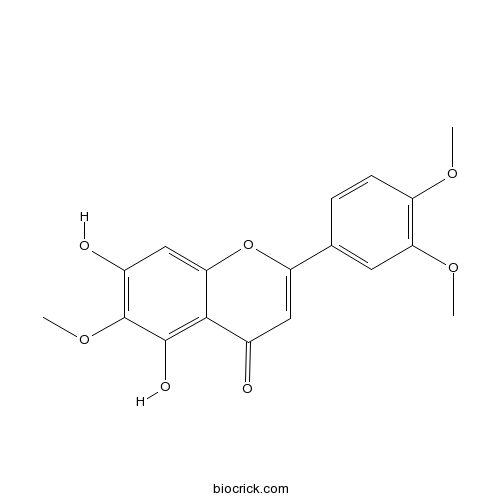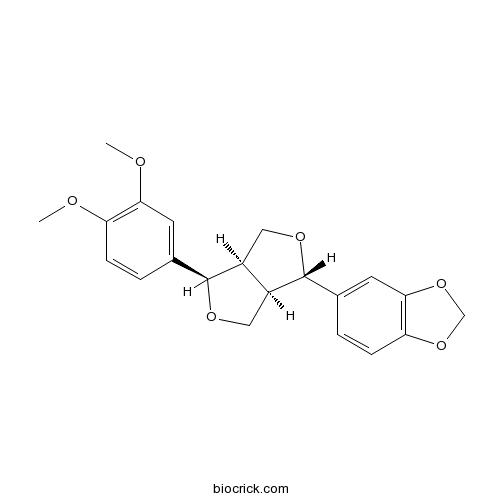Chrysanthemum indicum
Chrysanthemum indicum
1. The products in our compound library are selected from thousands of unique natural products; 2. It has the characteristics of diverse structure, diverse sources and wide coverage of activities; 3. Provide information on the activity of products from major journals, patents and research reports around the world, providing theoretical direction and research basis for further research and screening; 4. Free combination according to the type, source, target and disease of natural product; 5. The compound powder is placed in a covered tube and then discharged into a 10 x 10 cryostat; 6. Transport in ice pack or dry ice pack. Please store it at -20 °C as soon as possible after receiving the product, and use it as soon as possible after opening.
Natural products/compounds from Chrysanthemum indicum
- Cat.No. Product Name CAS Number COA
-
BCN5328
Diosmetin-7-O-beta-D-glucopyranoside20126-59-4
Instructions

-
BCN2336
Eupatilin22368-21-4
Instructions

-
BCN5022
Fargesin31008-19-2
Instructions

-
BCN5554
Linarin480-36-4
Instructions

-
BCN5658
Apigenin520-36-5
Instructions

-
BCN5388
Luteolin-7-O-glucoside5373-11-5
Instructions

[Comparative study on content of heavy metals in Chrysanthemum indicum and soil in different areas].[Pubmed: 30111049]
ICP-MS was used to determine the contents of five heavy metals such as lead (Pb), cadmium (Cd), mercury (Hg), arsenic (As) and copper (Cu) in Chrysanthemum indicum and soil samples. Pearson correlation and path analysis were used to analyze the effects of latitude and longitude and altitude on the content of heavy metal elements in Ch. indicum. To explore the relationship between geographical location of heavy metal content in Ch. indicum and the content of heavy metal elements in soil. The results showed that the Ch. indicum had high enrichment of Cd and had a synergistic effect on the absorption of five heavy metal elements. Elevation directly affected the accumulation of Pb and Cd in Ch. indicum and was a positive effect. The direct positive effect of latitude acts on the accumulation of Hg and Cu in Ch. indicum. The effect of longitude on the Cd content was the negative effect of longitude. The geographical location had different effects on the accumulation of heavy metal elements in Ch. indicum. There was a certain interaction between direct and indirect effects. Ch. indicum had different absorption and enrichment characteristics for different heavy metal species. When controlling the heavy metal content and medicinal material quality of Ch. indicum, we must fully consider the influence of geographical location on the quality of medicinal materials, select suitable geographic regions to carry out acquisitions, and choose a good ecological environment. Regional establishment of Chinese herbal medicine planting bases, or adopting certain agricultural measures to reduce the absorption of heavy metal elements in Ch. indicum herbs, while conducting research on chemical composition, strengthening the research on the effective forms of heavy metals, and paying attention to the safety of medicinal herbs.
Chrysanthemum indicum L. ethanol extract reduces high-fat diet-induced obesity in mice.[Pubmed: 29844801]
None
SSR marker development and intraspecific genetic divergence exploration of Chrysanthemum indicum based on transcriptome analysis.[Pubmed: 29695227]
Chrysanthemum indicum L., an important ancestral species of the flowering plant chrysanthemum, can be used as medicine and for functional food development. Due to the lack of hereditary information for this species and the difficulty of germplasm identification, we herein provide new genetic insight from the perspective of intraspecific transcriptome comparison and present single sequence repeat (SSR) molecular marker recognition technology.
Highly Oxidized Guaianolide Sesquiterpenoids with Potential Anti-inflammatory Activity from Chrysanthemum indicum.[Pubmed: 29400471]
None
Chrysanthemum indicum Inhibits Adipogenesis and Activates the AMPK Pathway in High-Fat-Diet-Induced Obese Mice.[Pubmed: 29298511]
Chrysanthemum indicum (CI) is widely distributed in China and many parts of the tropical world, and has been reported to have antibacterial, antiviral, anti-oxidant and immunomodulatory effects, but no information is available on its effects on high fat diet (HFD)-induced obesity. This was undertaken to investigate the mechanism responsible for the effect of ethyl acetate fraction of CI (CIEA) on adipogenesis, in vitro and in vivo models of obesity. In the in vitro study, differentiating 3T3-L1 cells were treated with media to initiate differentiation (MDI) in the presence or absence of CIEA with different concentrations, and in the in vivo study, C57BL/6 mice were fed with HFD and administered CIEA daily for six weeks. Garcinia cambogia (GC) was used as the positive control, and was administered in the same manner as CIEA. Results showed CIEA reduced HFD-induced body weight gain, epididymal white adipose tissue (eWAT), and liver weight. In addition, CIEA significantly decreased serum lipid profiles, including total cholesterol (TC), triglyceride (TG) and low density lipoprotein cholesterol (LDLc) and increased high density lipoprotein cholesterol (HDLc) levels. Furthermore, CIEA also reduced leptin levels and increased adiponectin levels in serum, and significantly decreased peroxisome proliferator-activated receptor [Formula: see text] (PPAR[Formula: see text]) and CCAAT/enhancer-binding protein (C/EPBs) levels, but increased PPAR[Formula: see text] level and the phosphorylation of AMP-activated protein kinase (AMPK) in eWATs and in the liver tissues of HFD fed obese mice. Taken together, these results indicate CIEA might be beneficial for preventing obesity.
Continuous biosorption of nickel from aqueous solution using Chrysanthemum indicum derived biochar in a fixed-bed column.[Pubmed: 28991804]
None


